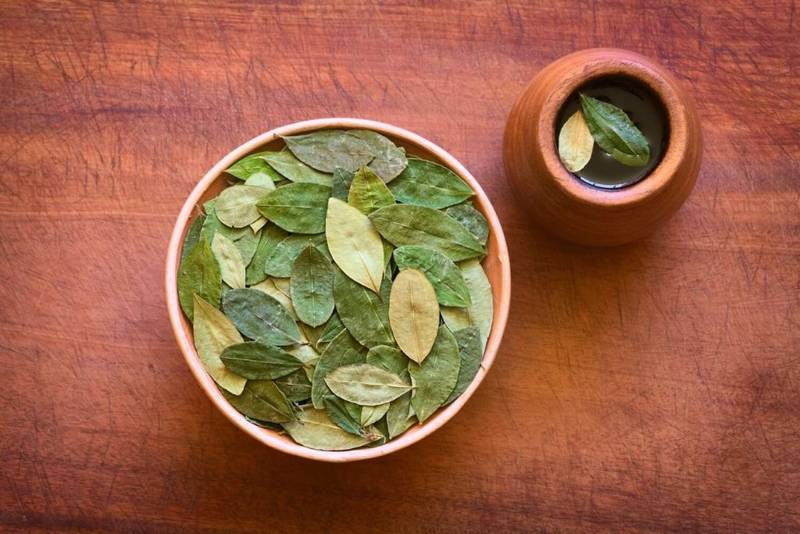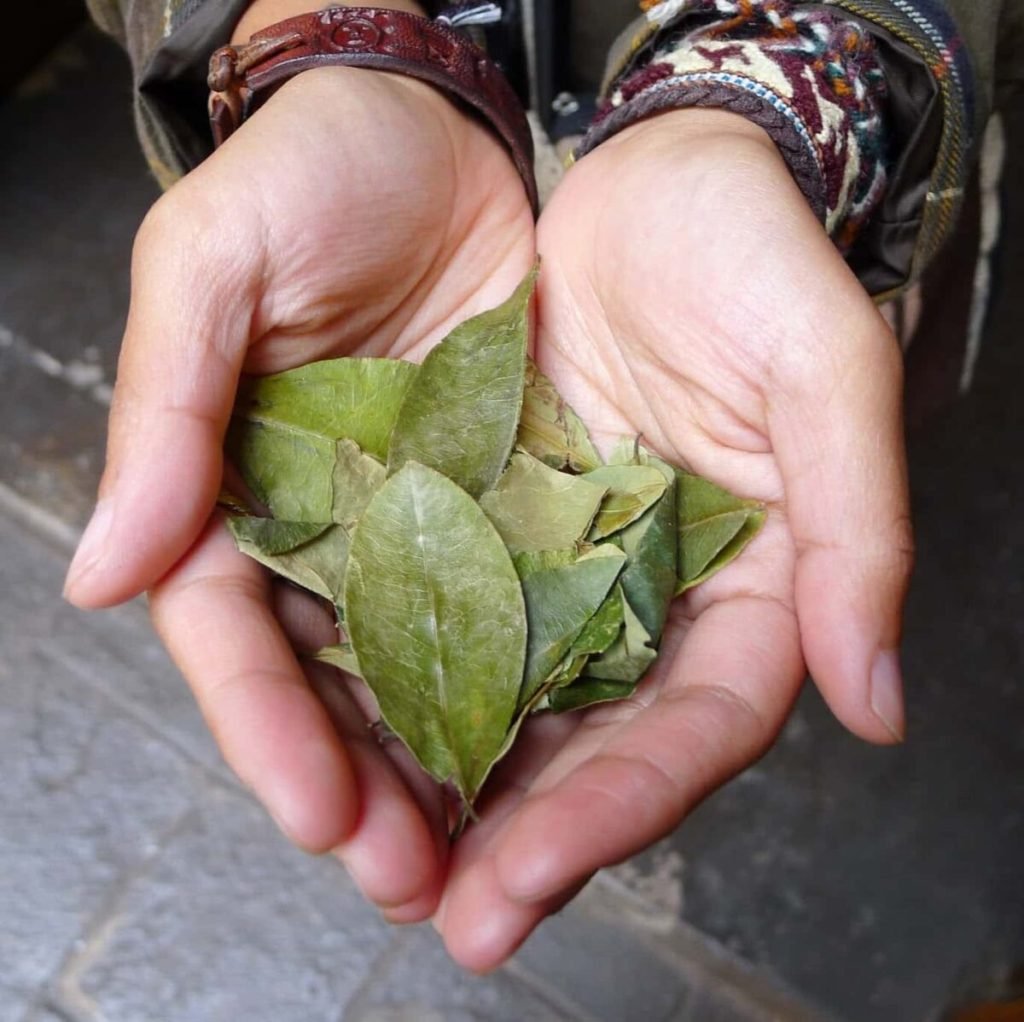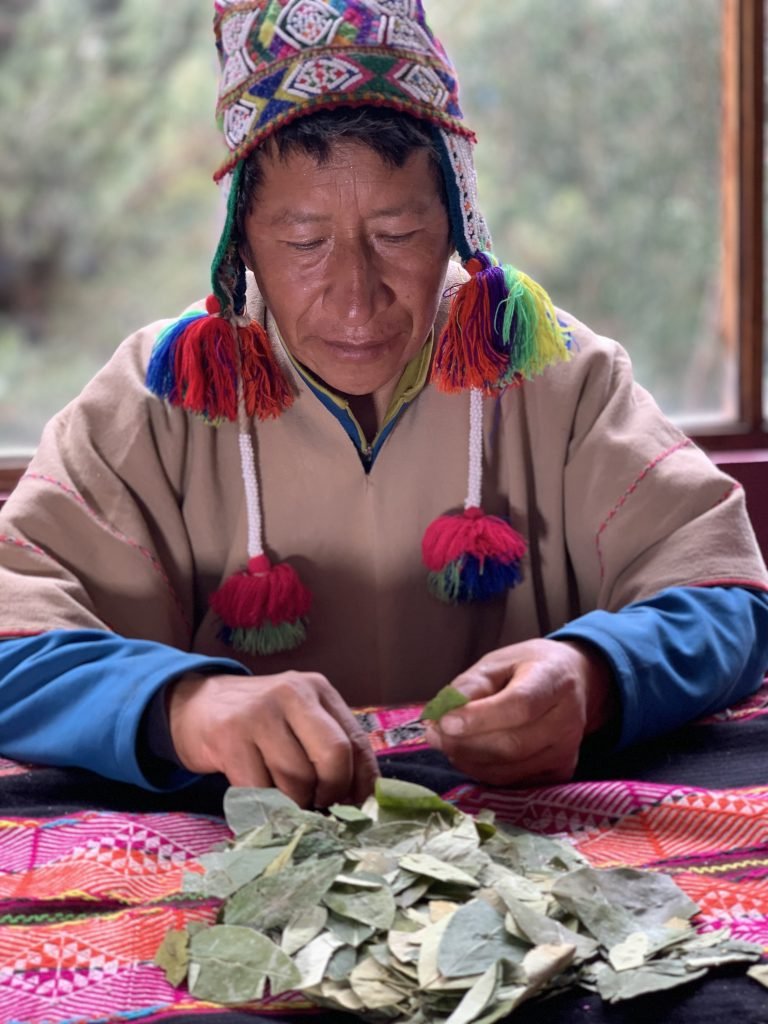Coca leaf is a natural component of the coca plant, native to the Andean regions of South America. During rituals, shamans often chew coca leaf to strengthen their spiritual connection, increase their energy and broaden their consciousness. Although coca is often associated with illicit cocaine use, the coca leaf itself has a number of benefits traditionally recognized by indigenous communities. In this article, we will explore some of these benefits.
Natural stimulant:
- Coca leaf contains natural alkaloids, including cocaine in very low concentrations. These compounds have stimulant properties and can help fight fatigue, increase energy and improve alertness. Many indigenous peoples of the Andes consume coca leaf to resist the effects of altitude and to cope with strenuous physical tasks.
Appetite suppression:
- Chewing coca leaf can reduce feelings of hunger and act as a natural appetite suppressant. This can be especially useful for people living in areas where food availability is limited, as it helps them extend the time between meals.
Medicinal properties:
- Coca leaf has been used in traditional Andean medicine to treat various health problems. It is considered a central nervous system stimulant and can help relieve headaches, muscle aches and stomach pains. In addition, coca leaf is believed to have diuretic properties and may help combat digestive problems.
Nutritional benefits:
- Coca leaf is rich in nutrients such as vitamins (A, C, E) and minerals (calcium, magnesium, phosphorus). It also contains antioxidants, which help fight free radical damage in the body. For this reason, some people consume coca leaf to supplement their diet and obtain these nutritional benefits.
It is important to note that coca leaf in its natural state is different from cocaine, which is a highly processed chemical that is harmful to health.
People should consume coca leaf consciously, respecting cultural traditions and local legislation.
The mysteries of the coca leaf

Due to its unique properties and the central role it plays in Andean culture, the coca leaf shrouds itself in mystery and fascination. For the indigenous communities living in the Andean regions of South America, the coca leaf is more than a plant: it is a symbol of their identity, their traditions and their connection to nature. In this article, we will explore some of the mysteries and meanings associated with the coca leaf.
Spirituality and rituals:
- The coca leaf plays an essential role in many rituals and ceremonies in Andean cultures. Indigenous peoples consider it sacred and have a deep spiritual connection with it. Chewing the coca leaf is a ritual act that people perform to establish communion with nature, the ancestors, and the cosmos. People believe that the coca leaf possesses spiritual powers and can bring protection, wisdom, and connection with the divine.
Ancestral knowledge:
- Centuries-old traditions and ancestral knowledge passed down from generation to generation root the coca leaf. The indigenous peoples of the Andes possess a wealth of knowledge about the cultivation, harvesting, preparation and proper use of the coca leaf. People transmit these secrets orally and keep them as cultural treasures. The mystery lies in the wisdom accumulated over the centuries. The coca leaf holds deep and valuable secrets understood only by the initiated.
Vital energy and balance:
- Believers attribute to the coca leaf a unique vital energy that can be channeled to balance the body, mind, and spirit. They consider it a powerful medicinal plant capable of curing illnesses and restoring physical and energetic balance. The mystery lies in understanding the energetic principles of the coca leaf and manipulating them to achieve internal and external harmony.
Connection with the earth and nature:
- The coca leaf is a symbol of the deep relationship between indigenous peoples and the earth. It grows at high altitudes, withstands adverse conditions, and people consider it a guardian of the Andes. Cocaine, a highly processed substance derived from the coca leaf, has created an aura of mystery and controversy around the plant, obscuring its true cultural and spiritual significance. The mystery of the coca leaf lies in reconnecting with its ancestral roots and understanding the deep respect and reverence it inspires in indigenous communities.
In short, the culture, spirituality, and wisdom of indigenous peoples root the mysteries of the coca leaf. Appreciating these mysteries requires respect, understanding, and intercultural dialogue. They immerse us in the richness of the sacred plant, revealing its deepest secrets.
Peruvian Shamans and the Coca Leaf

Shamans are fundamental in Andean cultures, maintaining a deep connection to the coca leaf in indigenous traditions. As spiritual leaders and healers, they use the coca leaf in their rituals, ceremonies and healing practices. We will explore the relationship between shamans and the coca leaf, highlighting its importance and significance in shamanic traditions.
They consider shamans as intermediaries between the human and spirit worlds. Shamans possess a deep knowledge of plants, herbs, and natural elements, including the highly valued coca leaf in their practice. For shamans, the coca leaf is a sacred tool and a source of spiritual wisdom.
Coca Leaf Shamanism: Diagnosis, Ritual, Power and Healing
- Shamans use the coca leaf for several purposes. First, people use it as a diagnostic tool. Shamans interpret formations by chewing and spitting the coca leaf in spiritual readings, revealing information about health and well-being. These spiritual readings of coca leaves access information about health and wellness as a means of gaining spiritual knowledge. Shamans can identify energetic imbalances, illnesses or emotional problems by reading coca leaves.
- In addition, the coca leaf plays an important role in shamanic rituals and ceremonies. People offer it to spirits and deities as a form of honor and respect. Shamans perform ceremonies of thanksgiving to Pachamama (Mother Earth) and nature spirits. They use the coca leaf as a symbol of spiritual union.
- Shamans also use the coca leaf as a power plant. It possesses energetic and protective properties. Shamans may chew the coca leaf to strengthen their spiritual connection, increase their energy and expand their consciousness during rituals. People perceive coca leaf as a spiritual ally that facilitates access to altered states of consciousness. It also favors connection with spiritual dimensions in shamanic practices.
- Finally, shamans use the coca leaf for healing purposes. Believers ascribe it medicinal properties, using it to address physical, emotional, and spiritual ailments. Shamans may prepare infusions or extracts from the coca leaf and administer them to patients as part of their healing practices. People believe that the coca leaf has the power to purify, balance, and strengthen the body and mind.
In summary
The coca leaf is essential in the shamanic practices of the indigenous peoples of the Andes. People value it as a sacred tool, a means to access the spiritual world, a symbol of connection with nature, and a source of healing. Shamans and coca leaf, symbols of wisdom and spirituality, highlight the importance of preserving ancestral indigenous traditions.





